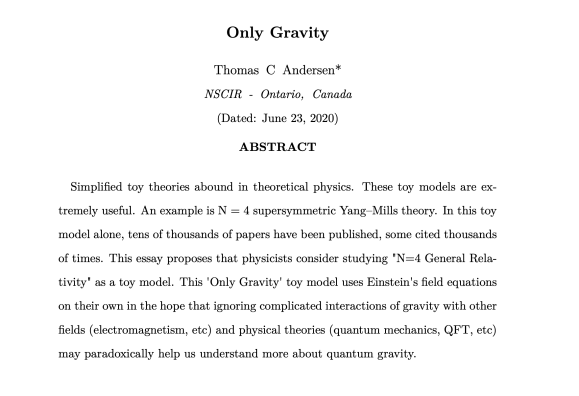The problem with dark matter in galaxies is that it’s just too organized. Dark matter seems to correlate too well with matter distributions.
What about a field associated with every nucleon that saturates at some level, called S here. (its saturated near dense matter like here on Earth or in the Milky Way plane, while when protons/neutrons get below a certain density, the field then eventually drops as the density of matter drops.
This solves the cuspy galaxy core problem, it also makes the BTFR (Baryonic Tully Fisher Relation) work, it also seems it would work on the bullet cluster, galactic clusters, etc.
BTFR – explained

The Baryonic Tully Fisher Relation is one of the most accurate relations in cosmology. It’s a huge thorn in the side of LCDM cosmology, since dark matter and regular matter are not supposed to be in lockstep with one another. See Stacy McGaugh
THE SMALL SCATTER OF THE BARYONIC TULLY–FISHER RELATION
With the S field presented here, there is a saturable field associated with every nucleon. When nucleons are about a mm apart or less on average, the S field is at some standard strength, then as the density lowers more, the S field maintains its density (or slowly loses density) until at some limiting low matter density this saturable field S starts to drop. By the point this happens there is ~100x more energy in the saturable field S than the baryonic density.
This effect can explain the BTFR as dark matter is present in quantities as a function of baryonic mass in some fashion.
Bullet Cluster
The bullet cluster poses a problem for MOND like theories – there seems to be excess dark matter causing lensing. So dark matter really exists, it seems. The S field solves this nicely. No one thinks that the lensing areas of the Bullet cluster are completely free of matter, it’s just that the dark matter is not located where the bulk of the matter is.

The contours show the density (line of sight) of dark matter, while the X-Ray image in orange – purple shows the colliding dense regular matter.
Galactic Clusters
Clusters of galaxies would not hold together without about 5 times the mass of the individual galaxies available between the galaxies to hold the galaxies together. See Galaxy clusters prove dark matter’s existence as an intro by Ethan Siegel .
The mechanism is clear – the intergalactic dust and gas provide the framework to energize a large S field which keeps the cluster gravitationally bound.
Properties of the S field
The S field is associated with matter and has a limiting high density. At low densities (ie halo galactic densities) the field has a mass of up to about 10 (or 100?) times the mass of a nucleon, per nucleon.
Where does the energy come from? It’s dark energy – just clumped. So S is dark energy. There is always a flow of it running around, and its pulled from dark energy as needed to saturate around matter.
What is the form of the field?
What is the minimum energy density in say GeV/m3 ? Dark Energy has an energy density of about 0.5 GeV/m3 .
The max is determined by the maximum density measured for dark matter which is about 0.5 GeV/cm3 (note the centimeter scale used by astronomers when dealing with matter clouds) see my earlier related post Is Dark Matter merely Inactive Matter? so about 1003 or a million times the density of dark energy.
Thus the S field saturates at a density of ~ 5e5 GeV/m3 and is present all around us.
The S field density is then some function of the matter density. It turns out that it’s a cumulative effect from all matter enclosed inside ‘R’.
Stacy S. McGaugh and Federico Lelli
Consequently, the dark matter contribution is fully specified by that of the baryons. The observed scatter is small and largely dominated by observational uncertainties. This radial acceleration relation is tantamount to a natural law for rotating galaxy.
From http://stacks.iop.org/0004-637X/836/i=2/a=152?key=crossref.21cde6b778a1e42d6160598a6ba24e03
Start at Equation 22:
Then use and simplify to
Thus the quantity of DM inside a certain radius is wholly dependent on the amount of baryonic matter inside that radius. The S field is a cumulative effect of density of regular baryons.
When I use this on density I get
This equation states that the density of dark matter depends only on the enclosed average density of baryonic matter.
Calculating the acceleration at R , given a 35kPc distance R, and a density of baryons of 1GeV per cm3 gives = 1.2×10-10 m/s2 – ie
which is the Milgrom acceleration. So that’s the cut where dark matter starts to be apparent, as the denominator starts to take off.
Of course, this density equation has limits on both ends. The dark matter S field has a maximum density of about a GeV per cm3 and once the density goes down to about dark energy levels one no longer calls it dark matter. Don’t forget my density version of the equation requires the average density inside R for the galaxy/gas cloud/cluster.
In my mind this S field is HFGW, but it’s not important what is the nature of the field, vs the mass of the field.
It seems to me that battling it out as MOND vs LCDM is perhaps not the best way to approach the problem as there are obviously more models around that might work. One just has to throw out some part of standard model physics!
Looking at the above more, I’m not convinced that sticking exactly to the MOND formula for mass and density is the way to go with this S field idea. I’m hoping there is a function where the density of DM is only given by the local density of matter, but perhaps that will not work. Perhaps there is something happening where DM depends on the total SUM of all all the matter interior to the radius R.





 Andersen, T. C. on ORCID
Andersen, T. C. on ORCID




The normal spiral galaxy rotation curve of HII has a low point outside the inner region then a rise to a knee then a change to declining, nearly flat, and rising. Taking the rotational velocity at the knee produces a better correlation than at the maximum extent, especially for rising RCs.
The rising RC (low surface brightness ) galaxies falsify TF and MOND.
The STOE model produces a better explanation for all spiral galaxy types.